Canadian Canola Overview – May ’21
Executive Summary
Soybean meal has historically been the most widely used protein supplement in dairy cow rations, due in large part to its widespread availability, however canola provides an alternative source of high quality protein. The U.S. accounted for just three percent of global canola meal production throughout the past five production seasons, however an abundance of supply is located nearby in Canada, as canola is the major oilseed crop grown throughout the country. Important points to consider include:
- The ’21-’22 Canadian canola crop is expected to rebound 6.8% from the five year low level experienced throughout the previous production season but remain below historical record high production levels. ’21-’22 Canadian canola seeding intentions of 21.5 million acres rebounded to a three year high level, up 1.6% from the previous year.
- The Canadian canola crop is primarily grown in the western providences of Alberta, Saskatchewan and Manitoba, much of which was been recently in an abnormally dry to moderate-to-severe drought state. Significant precipitation is needed in particular within southeast Saskatchewan as the 2021 planting season continues. Canadian canola plantings typically occur in late April to mid-May but can occur as late as early June, with the consequence of reduced yields.
- Canadian canola ending stocks have recently reached eight year low seasonal levels but are expected to rebound to an extent throughout the ’21-’22 production season, primarily on an associated projected increase in production. When normalized for usage, Canadian canola stocks and Pacific Northwest canola meal prices have exhibited a correlation coefficient of -0.68 since 2000, with canola meal prices reaching a record high level shortly after the Canadian canola stocks-to-use ratio declined to a record low level.
Use in Dairy Cow Rations
Soybean meal has historically been the most widely used protein supplement in dairy cow rations, due in large part to its widespread availability, however canola provides an alternative source of high quality protein. The name “canola” is a contraction of Canadian Oil, Low Acid and is derived from low toxicity rapeseed. Canola is grown for its oil while the meal, which is a remaining byproduct after the oil is pressed from the seed, is used as a protein supplement. The majority of canola meal in the U.S. is fed to dairy cows because the high fat content of the meal enhances milk production.
Soybeans have accounted for 60% of total global oilseed production over the past five years, whereas rapeseed (canola) accounted for only 12% of global oilseed production throughout the period. Despite the relatively small percentage of global oilseed production, canola remains among the largest oilseed protein feed sources for dairy cows after soybean meal.
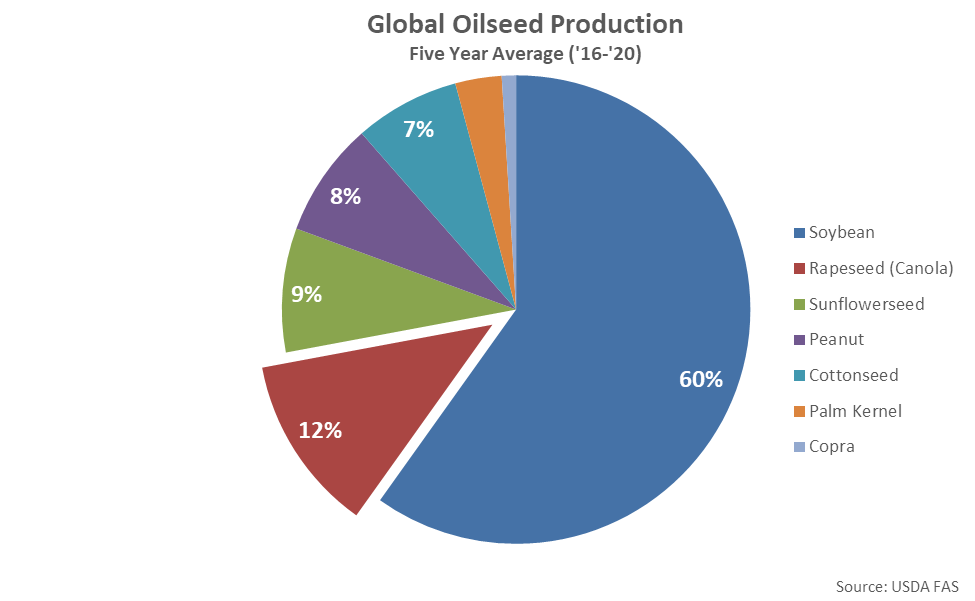
Global Canola Overview
Global canola meal production is distributed among a few major producers, with the EU-27+UK, China, Canada and India combining to account for over 80% of total production throughout the past five production seasons. The U.S. accounted for just three percent of global canola meal production throughout the past five production seasons, however an abundance of supply is located nearby in Canada, as canola is the major oilseed crop grown throughout the country.
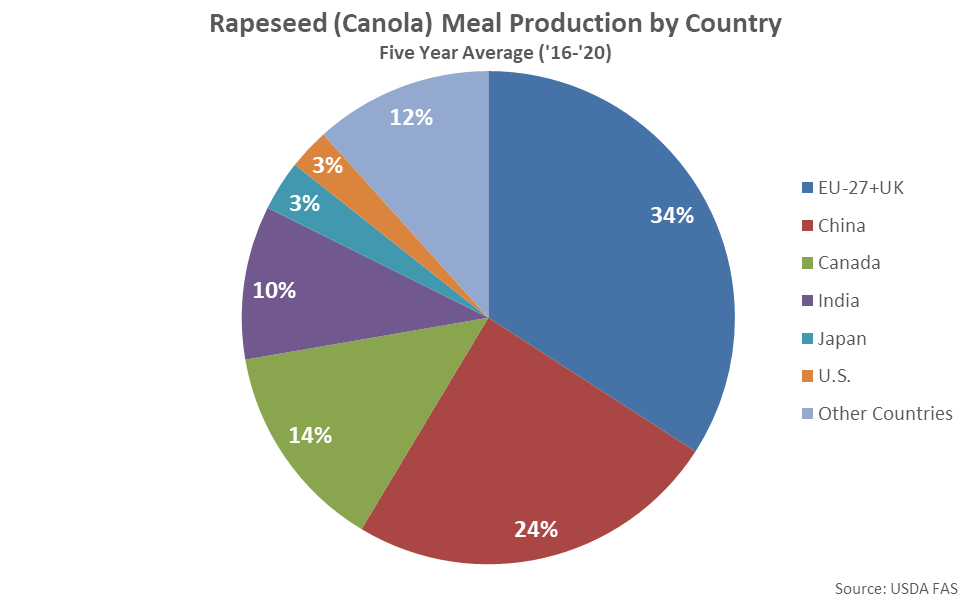
The EU-27+UK and China are not only the largest global producers of canola meal but are also the largest global consumers of the oilseed, combining to account for over 60% of total global consumption over the past five years. The U.S. is the third largest global consumer of canola meal, importing significant quantities from Canada. The U.S. is the primary importer of canola meal because of its proximity to Canada and the ease of cross-border trade. Canada has historically accounted for just under two-thirds of world trade in canola seed, meal and oil throughout the past five years and over 98% of all U.S. canola imports.
According to the Canola Council of Canada, canola generates one quarter of all farm cash receipts throughout Canada, with 90% of the product being exported outside of the country as seed, meal or oil. The U.S. is the largest importer of Canadian canola meal, accounting for over 80% of total Canadian canola meal export volumes throughout the past ten years.
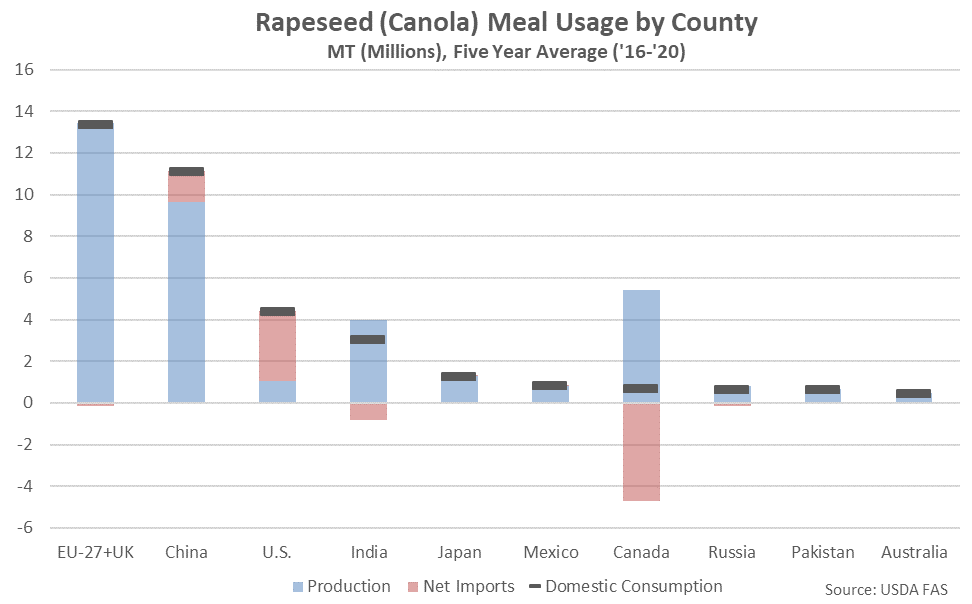
According to USDA projections, ’20-’21 global canola production is projected to have rebounded 2.0% from the four year low level experienced throughout the previous production season but remained 5.8% below the record high levels experienced throughout the ’17-’18 production season. ’20-’21 global canola production was projected higher on increases in Australian, Indian and Russian production, while Ukrainian and Canadian production was projected most significantly below previous year levels. ’21-’22 global canola production projections are not yet available.
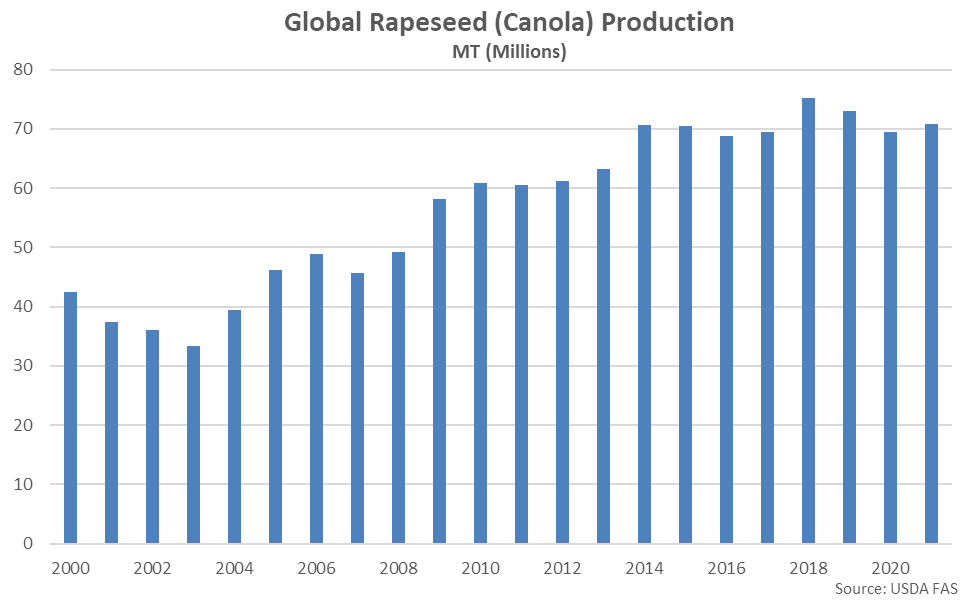
Canadian Crop Update
The domestic canola crop is best looked at when combining both U.S. and Canadian crops due to the U.S. importing significant quantities from Canada. Canada’s canola output increased by a compound annual growth rate of 10.9% over the 15 year period ending in the ’17-’18 peak production season, prior to declining over the most recent three production seasons.
’20-’21 annual Canadian canola production is projected to have declined to a five year low level, finishing 4.5% below the previous year and 12.8% below the recent ’17-’18 highs. Declines in ’20-’21 Canadian canola production were primarily due to a reduction in planted acres, while yields were marginally below trendline. Regional excessive moisture, dryness and disease contributed to the decline in yields experienced throughout the most recent production season. According to the USDA, disease continues to remain the main reason for farmers to rotate out of canola every two to four years, or more, depending on the region.
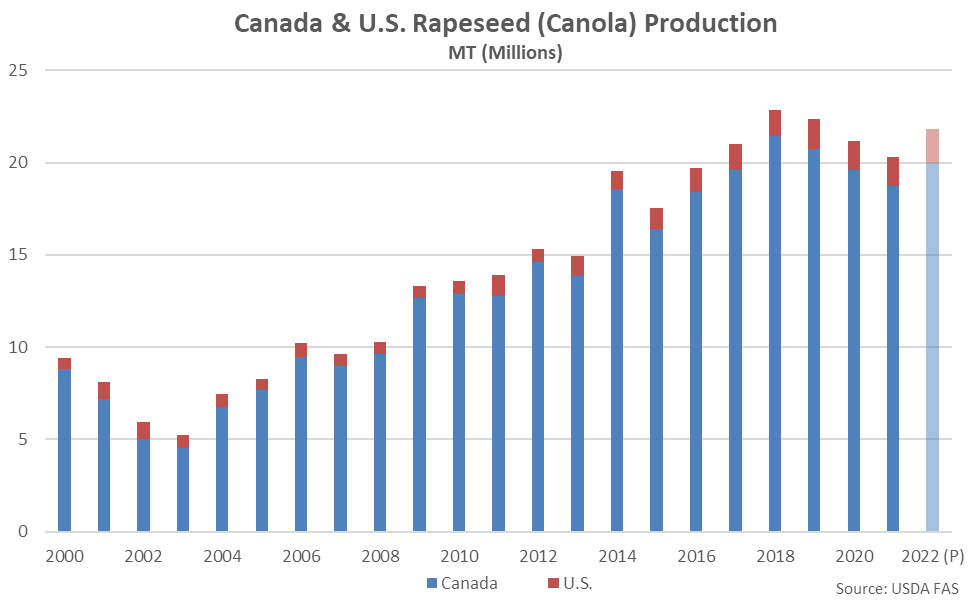
According to the USDA, ’21-’22 Canadian canola production is forecast up 6.8% from the previous year on a recovery in yields and an increase in area planted. ’21-’22 projected production levels would remain 6.8% below the ’17-’18 highs, however. According to Statistics Canada, ’21-’22 Canadian canola seeding intentions of 21.5 million acres rebounded to a three year high level, up 1.6% from the previous year.
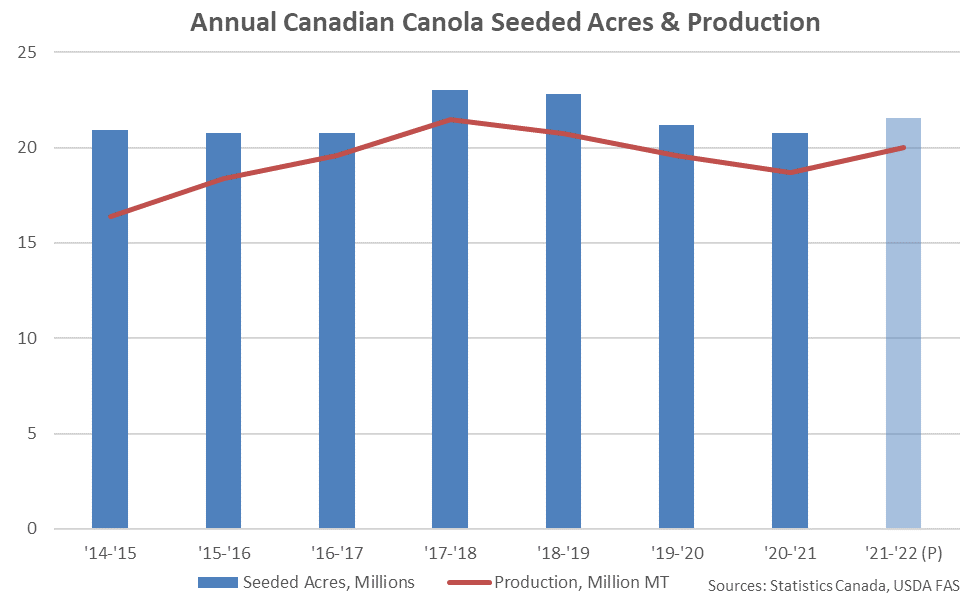
Canadian Drought Monitor
According to the Canola Council of Canada, Canadian canola is primarily grown in the western providences of Alberta, Saskatchewan and Manitoba, with minimal amounts grown in British Columbia, Ontario and Quebec.
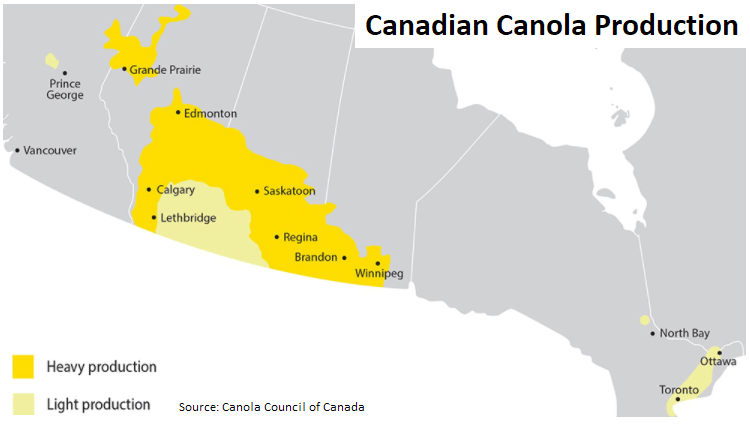
An overlay of regional Canadian drought monitor conditions as of the end of Apr ’21 show the majority of the heavy canola production areas being in an abnormally dry to moderate-to-severe drought state. Significant precipitation is needed in particular within southeast Saskatchewan as the 2021 planting season continues. Canadian canola plantings typically occur in late April to mid-May but can occur as late as early June, with the consequence of reduced yields.
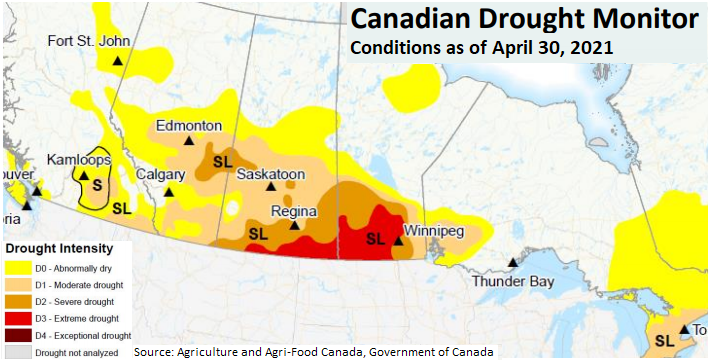
Canadian Canola Ending Stocks
According to Statistics Canada, Canadian canola stocks declined to an eight year low seasonal level as of Mar ’21, finishing 37.7% below previous year levels. USDA projections largely align, with ’20-’21 Canadian canola ending stocks projected to reach an eight year low level. The USDA defines July as the end of the Canadian canola marketing year.
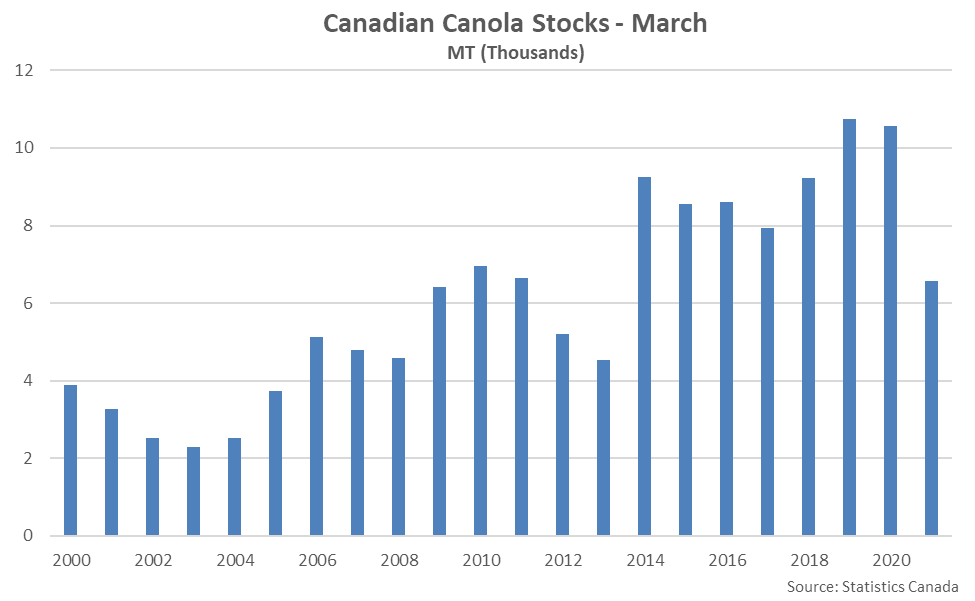
When normalized for usage, Canadian canola stocks and Pacific Northwest canola meal prices provided by USDA AMS have exhibited a correlation coefficient of -0.68 since 2000. Pacific Northwest canola meal prices reached a record high level shortly after the Canadian canola stocks-to-use ratio declined to a record low level throughout the ’12-’13 production season. More recently, canola meal prices have once again rallied in line with a tight Canadian canola stocks-to-use ratio. The USDA expects the Canadian canola stocks-to-use ratio to rebound throughout the ’21-’22 production season, however, primarily on an increase in ending stocks associated with a rebound in production.
Canola Meal vs. Soybean Meal Prices
Monthly Pacific Northwest canola meal prices have been strongly correlated to monthly CME soybean meal futures prices, historically, exhibiting a correlation coefficient of 0.95 since 2000. CME soybean meal prices have traded at a $55/ton average premium to Pacific Northwest canola meal prices over the period.
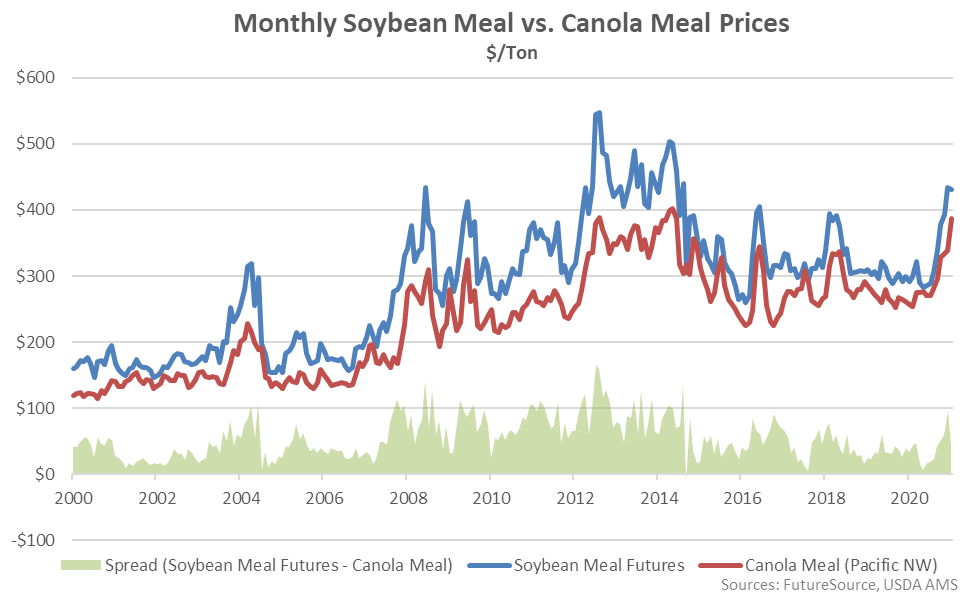
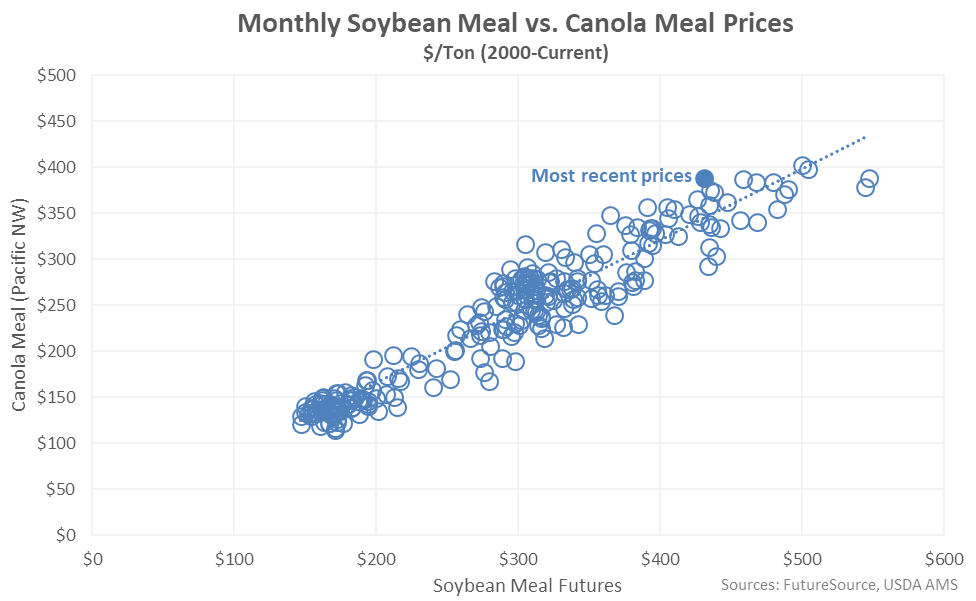
Summary
The U.S. accounts for just three percent of global canola production but is the largest global canola meal net importer, with the vast majority of imports originating from within Canada. The ’21-’22 Canadian canola crop is expected to rebound 6.8% from the five year low level experienced throughout the previous production season but remain below historical record high production levels. Risks to rebounding production levels include heavy production regions being in an abnormally dry to moderate-to-severe drought state throughout the early portion of the planting season.
Currently tight Canadian canola stocks are expected to rebound from recently experienced eight year low seasonal levels on the associated projected rebound in production levels. Pacific Northwest canola meal prices have historically exhibited a significant negative correlation with Canadian canola stocks-to-use ratios, strengthening when stocks are tight relative to usage. Pacific Northwest canola meal prices correlate well with CME soybean meal prices for cross-hedging purposes.